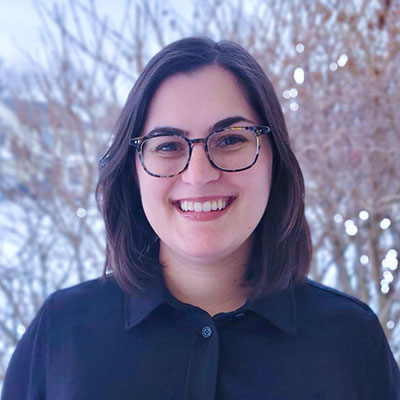Over the past several years, the number of healthcare applications built at Dimensional Insight on Diver Platform has exploded. We now have 15 healthcare applications! Gabrielle Amarosa is a crucial member of our healthcare applications team. I sat down with her this week to better understand her part in developing these applications – and other responsibilities at Dimensional Insight.
Gabrielle, what is your role at Dimensional insight, and what responsibilities does your role entail?
My title is “Lead Healthcare Business Intelligence Consultant,” and I work on the Healthcare Applications Team. Our team is exciting. Our primary mission is to design, develop, and maintain healthcare applications such as Hospital Operations, Ambulatory Operations, etc. We also have responsibilities with direct customer work.
Our team does direct customer work partly because of the high demand for consultants and partially because customer work informs our application development work. For example, customer work can reveal feedback on the pain points and where we can improve applications. Working with the customer creates a “cycle of feedback.” I spend about 60% of my time on application work and 40% on customer work.
More specifically, my responsibility is to be involved in the design and planning of new applications. I help discuss what belongs in that application and which metrics we want to track, and then we work backward to plan how we technically develop that application. I’m also extensively involved in the development – the code work – of creating and updating those applications.
Once an application is stamped and sent out the door, we support the organization’s consulting arm as they install and customize it. We can provide some expertise there, especially when it’s a new application for the consultant. Once an application is launched and used by customers, we provide regular maintenance, including fixing bugs and making improvements. I’m also very involved in planning for improvements and doing updates.

Tell me more about the process of developing applications.
What’s remarkable is we’re in a fortunate position to be centralized and able to talk to many hospitals and healthcare systems. So we have a direct line to hearing what problems they are trying to solve.
When creating these applications, even though we’re using available tools, we’re aggregating all that firsthand industry knowledge and saying, “To solve this problem, here’s what we would put into it. “This would be a jumping-off point for a customer to solve these problems or do that analysis. I think that’s special about our work process – the integration of all we know as a team. We can see which initiatives are vital to customers. Knowing what is critical is helpful when deciding our next application initiative.
This sharing of expertise is even something that is happening organically within our customer base.
I witnessed it at our users’ conference (DIUC). I learned that several customers I work with have an email chain amongst themselves (Diver users from three different healthcare organizations). They will often reach out to each other to brainstorm how to solve a problem they’re facing at their organization using Dimensional Insight technology before or in addition to reaching out to us directly. I was impressed by how our customers have a community of support among themselves.

What is the most difficult aspect of your job?
As I said earlier, we have a mix of application development and client work. Although there are a lot of benefits to doing both types of work, it can be challenging to juggle. So every Monday, we meet as a team, discuss our priorities, and develop a plan for the week. For example, what are the current projects? Are we releasing a new application? Or new functionality?
We go into the week with this plan. But sometimes unexpected customer requirements pop up and must be addressed. Sometimes we help out with support tickets. If something is not working or a customer needs our help – our plans change. Sometimes, these urgent requests come up. So, the most challenging part of my job is being flexible enough to prioritize customer needs while making meaningful progress on our application initiatives.
What’s most rewarding?
It is rewarding to finish an application or a new application feature and have it installed at a customer site. But, it is even more rewarding to get feedback that it’s working, that it’s solving a real problem for them, and that it’s making a tangible improvement in what they’re doing day-to-day.
Also, we’ve curated a collaborative team of like-minded people. We love a technical challenge or exciting data problem. We are all invested in what everyone else on the team is doing. As a result, our team culture is enriching. We get to collaborate and be excited when we solve something together. In addition, there is a sense of pride when our teammate has a really good or out-of-the-box idea for addressing a problem.
What are your favorite types of projects?
I’ve talked about the type of projects we do, but I also have one part of my role that I haven’t discussed yet. That is, I love working on government-regulated measures. For example, the Center for Medicare and Medicaid Services (CMS) has a variety of outcome measures that track hospital readmissions, mortality, the average length of stay, and excess days in acute care (EDAC) after a hospital visit. The measures are technically dense and are updated yearly. Because these measures are part of our healthcare applications, we must keep our applications up to date with any measure changes. We usually provide these CMS updates to our customers in the late summer to early fall.
I’ve been involved with that process since I joined Dimensional Insight. First, we take the government’s documentation and sift through it to see what’s relevant to our code base and how our customers use those measures. Then we put together a plan to do an update that causes minimal disruption to our customers and their end users but keeps them up to date with the latest specifications.
Many people don’t enjoy working on these CMS updates because government documents can be dry and complicated. But I find it rewarding because those measures are so interesting. They’re going to be so crucial to the transition to value-based care.
The CMS updates also allow us to engage with very self-sufficient customers who don’t reach out to us often. Every fall, it gives us a chance to check in and say, “Hey, we have the new CMS package. How are things going? What are your current projects? Do you need any help installing this?” So for many reasons, I always look forward to that time of year. I love working on that annual process.
Why should people pick Dimensional Insight over our competitors?
From a technical perspective, our platform is unique. It is not like anything else on the market. It covers everything. Our solution is truly end-to-end, all the way from getting the basics of the data down through data governance and through to some exciting dashboards and visualizations that are accessible and relevant to various data consumers in an organization.
There is also something I touched upon earlier about putting the customer first. If we get a request because a customer is trying to solve a problem we haven’t encountered before, we don’t view it as a hassle. On the contrary, we consider it an exciting challenge. That is the sort of thing we find fulfilling to do. Everyone is thrilled to go out of their way to work with that customer.
That is something that sets us apart from the competition. We really are customer focused. We love encountering unusual or challenging questions because it pushes us to think differently. We have cultivated a culture where that’s what we enjoy doing. Customers with complex problems will not get that sort of treatment from our competitors.

- Meet the Dimensional Insight Team: Gabrielle Amarosa - December 1, 2022
- What You Need to Know About President Biden’s Marijuana Pardon - November 2, 2022
- How to Ace this Year’s OND - September 27, 2022



